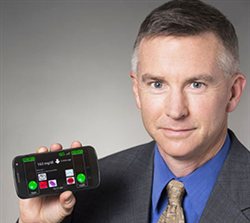An Artificial Pancreas System in Action
When JDRF started the Artificial Pancreas Project in 2006, the project was long on theoretical concepts but short on hard data. Scientists believed there should be a way to improve daily T1D management by connecting the reading from a continuous glucose sensor to control the operations of an insulin pump in a closed loop system – but the tools to do these experiments were limited and the path was unclear.
A few short years later, this area of T1D research, which aims to remove some of the impact of T1D from people’s lives by reducing dangerous high and low blood sugar levels and the complications that may result, has gone from a theory to a reality in widespread clinical testing. Not only are researchers continuing to refine this developing technology with the goal of eventually making it available to all people with T1D, but dozens of people with T1D have had the opportunity to test an artificial pancreas system by participating in human clinical trials.
The earliest artificial pancreas system trials focused on testing devices in a closely monitored setting to ensure patient safety. These trial participants stayed in a hospital for the trial duration and were followed closely by a medical team. The first rounds of trials showed promising results, but because the trials took place in hospitals, it was too early to conclude that an artificial pancreas system would be helpful with blood sugar management in a “real-world” setting, where people with T1D may face unpredictable circumstances and choices that can impact their glucose levels.
Last summer, JDRF announced a significant step forward in the development of artificial pancreas systems – ongoing clinical trials showed that artificial pancreas technology was proving successful in outpatient, more “real-world” settings. Study results released at the 72nd American Diabetes Association (ADA) Scientific Sessions revealed that participants in ongoing trials at international sites in France and Italy were able to use an artificial pancreas system for 18 hours outside of a hospital setting, while keeping good control of their blood sugar levels.
This past fall, JDRF had the unique opportunity to film the experiences of an artificial pancreas clinical trial participant at the University of Virginia. Tom Brobson, JDRF’s National Director of Research Investment Opportunities, was diagnosed with type 1 diabetes in 2004 and joined JDRF as a staff member shortly after that.
According to Tom, “Being diagnosed with T1D at age 44 felt like part of my life was being taken away – becoming involved with JDRF was like getting it all back.”
Participating in clinical trials was another way that Tom could make a difference and help to advance T1D research. In 2007, he began participating in artificial pancreas clinical trials and returned in 2009 and again in 2012.
“I participate in clinical trials because I want to see a whole progression of advances leave the laboratory and become life-changing therapies for those of us with T1D.”
Tom’s third experience being connected to a functioning artificial pancreas system was quite different than the two previous times.
“In 2007,” Tom explains, “I was in a hospital bed with wires running all over the place. We had to have two laptops running the software, my doctor had to check every single step the system wanted to make, and I couldn’t leave the room. By 2009, things had progressed, everything sort of fit into a fanny pack, there were still wires, but fewer of them, and I could walk around the hospital a bit – I even got on an exercise bike. The laptops were still running things but they were out of sight in a different room connecting via a wireless signal. All of this was needed because in these first attempts safety was paramount. It still is, of course, but in 2012, the laptops were gone and the system was running on a smartphone! This time, we left the hospital and went into the real world for three days.”
As part of the 2012 trial, Tom was able to walk around town and eat out at restaurants to test how the device would function in situations that people with T1D face on a daily basis.
In the video below, you’ll see Tom’s portable smartphone artificial pancreas system in action and learn more about how JDRF has managed to efficiently accelerate this groundbreaking technology in just a few years.
[View:http://www.youtube.com/watch?v=XlNsak3UWWg]
If you are interested in participating in a clinical trial, please visit JDRF’s Type 1 Diabetes Clinical Trials Connection at http://trials.jdrf.org. This is a service that provides information and matches people with T1D clinical trials for which they may be an appropriate participant. You can also find more information on artificial pancreas trials through the website of the JDRF Artificial Pancreas Consortium: http://jdrfconsortium.jaeb.org.
